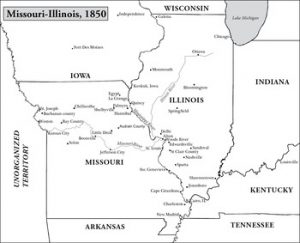In May of 1855, nine enslaved people escaped the city of St. Louis, Missouri in a bid for freedom.
The plan was for the slaves to be rowed across the Mississippi River to Illinois and then hidden in a wagon destined for Chicago. This escape was not spontaneous, but carefully arranged by the Knights of Liberty, one of many organizations that helped slaves escape from their slaveholders. The identified agents behind this escape plot were Mary Meachum (pictured right), leader of the organization, and Judah Burrows and Isaac Breckenridge, two other free blacks. Unfortunately, St. Louis police found out about the plot and caught up with the fugitive slaves on the riverbank. Little is known about what happened during this confrontation except that “five of the runaways were taken” by the police. Perhaps the other four found freedom, or perhaps they never made it across the river.[1]
So many similar escape stories exist in the historical record, sometimes with more information available and sometimes less. Large gaps of information remain, but historian Richard Blackett describes many of the most revealing episodes in his seminal work, The Captive’s Quest for Freedom: Fugitive Slaves, the 1850 Fugitive Slave Law, and the Politics of Slavery (2018). Noted historian Eric Foner calls Captive’s Quest, the “most comprehensive account of the workings of the Fugitive Slave Act of 1850 and opposition to it.”[2]
Blackett spent years meticulously researching the history of the antebellum fugitive crisis for The Captive’s Quest for Freedom, even writing in the book’s introduction that “when I began I was a father of four; now I am the proud grandfather of six!”[3]
The sheer volume of Blackett’s research is clear throughout the book, which is organized into chapters based on different border states and the networks of escape that grew from them.

Map of Missouri and Illinois border ca. 1850, courtesy of Cambridge University Press
The chapter that covers escapes from Missouri, “one of the zones of maximum conflict,” mentions dozens of escapes.[4] Most slaves from Missouri sought freedom in Illinois, crossing the border at least initially into a hostile southern region known as Egypt, and then traveling to more welcoming cities further North such as Chicago.[5] Blackett explains that attempted escapes involving large groups took place much more frequently in border states such as Missouri. He identifies a total of fourteen antebellum cases of group escapes, also known as slave stampedes, from the state of Missouri.[6]
Blackett uses the word “stampede” a total of seven times throughout the book. The term is first introduced in the second chapter, which focused on reactions to the 1850 Fugitive Slave Law. “Group escapes,” Blackett writes, “or what slaveholders took to calling stampedes…increased substantially, accounting for fully 36 percent of the escapes in the 1850s.”[7] Other than identifying key individuals credited for directing large amounts of slave stampedes, such as Mary Meachum and the Knights of Liberty, Blackett directs more of his focus on the subject towards the public’s reaction to such stampeding efforts. Blackett repeatedly claims throughout the text that it was particularly these mass escapes which caused much of the slaveholders’ discontent in the years before the Civil War, writing that “group escapes also suggested a level of planning and coordination that raised the levels of anxiety among slaveholders.” [8]
Slaveholders’ anxiety was a huge factor in the increasing tensions between North and South, argues Blackett. Because of this, Blackett claims, every single escape, whether successful or not and whether group or individual, had the “potential to create deep political crises in the communities in which it occurred.” [10] Overall, the picture painted by The Captive’s Quest for Freedom reveals a country in deep political and social turmoil, with fugitive slaves and anxiety over slave stampedes at the heart of the crisis.
[1] R.J.M. Blackett. The Captive’s Quest for Freedom: Fugitive Slaves, the 1850 Fugitive Slave Law, and the Politics of Slavery (New York: Cambridge University Press, 2018), 143.
[2] Eric Foner, review of The Captive’s Quest for Freedom, cover, Blackett, Captive’s Quest.
[3] Blackett, xv.
[4] Blackett, 139.
[5] Blackett, 150.
[6] Blackett, 139.
[7] Blackett, 50.
[8] Blackett, 393.
[9] Blackett, 88-134.
[10] Blackett, xii.
